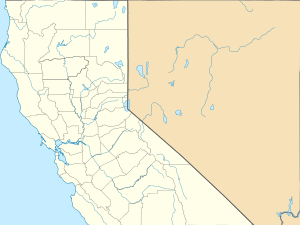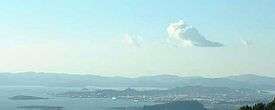Brooks Island
 The main portion of Brooks Island. At right is the start of the sandspit that extends about two miles west of the main island. Beyond the spit is the small rock of Bird Island. | |
 Brooks Island | |
| Geography | |
|---|---|
| Location | San Francisco Bay, Richmond, California |
| Coordinates | 37°53′47″N 122°21′19″W / 37.89639°N 122.35528°WCoordinates: 37°53′47″N 122°21′19″W / 37.89639°N 122.35528°W |
| Adjacent bodies of water | Richmond Inner Harbor |
| Area | 75 acres (30 ha)[1] |
| Length | 2 mi (3 km)[2] |
| Width | 0.25 mi (0.4 km) |
| Highest elevation | 160 ft (49 m)[2] |
| Highest point | Jefferds Peak |
| Administration | |
|
United States | |
| State | California |
| County | Contra Costa |
| City | Richmond, California |
| Demographics | |
| Population | 1 (2009)[2] |
Brooks Island is a 75-acre (30 ha), mostly flat strip of land extending from a round hill which peaks at 160 ft (49 m) in San Francisco Bay, located just south of the Richmond Inner Harbor in Richmond, California.[1][2][3]
Geography and geology
The rock that forms the main peak of the island is radiolarian chert underlain by limestone and graywacke sandstone. All these rocks are part of the Franciscan Assemblage, the same range as Albany Hill, 3 miles south, and the Coyote Hills, 25 miles south in Hayward.[2] This Franciscan formation is derived from sediments laid down in the sea west of San Francisco during the Late Jurassic and Cretaceous (150-66 million years ago) and then scraped off onto the edge of the North American plate during the subduction of the Farallon plate.[2][4] The main portion of the island covers an area of approximately 47 acres (19 ha).[1]
A short distance from the southwest coast of the main island is Bird Rock or Bird Island.
The sandspit that extends for about two miles west of the main island formed along a breakwater that was installed in the 1920s to preserve a deepwater channel to the Richmond Inner Harbor.[1][2]
During the last ice age San Francisco Bay was a valley, and Brooks Island was just one hill of many along its western slope. As sea level rose, the valley was flooded and Brooks Island was cut off from the rest of the East Bay.[2] Although the island is quite small, there is a permanent spring, which is used by the caretakers as a water source.[2]
Flora and fauna
The island hosts salt marshes, tidal flats and has a rise of 160 ft (49 m). It is home to many bird species, including herons and egrets, and provides their nesting sites. Some parts of the islands are off limits to visitors to protect nesting sites. Other names for the island include: Isla de Cármen, Rocky Island, Bird Island, and Sheep Island.[3]
Brooks Island is a habitat for harbor seals that stop at the island from their nearby rookery on the Castro Rocks.[5]
History
Ohlone period
On the island are the remains of several shellmounds left from prolonged occupation by Native Americans, most likely people from the Ohlone tribe, sustained by the abundant sea life in the surrounding bay. The first archeological excavation on Brooks Island was conducted by Nels Nelson of UC Berkeley in 1907. A more systematic excavation of the largest shellmound was performed by George Coles (d. 2015) of Contra Costa College during the 1960s, which produced carbon-14 dates of 1,700–2,000 years before present for the oldest materials in the mound. Coles estimates that the Ohlone occupation of the site may date back more than 3,000 years. His study found bones from cormorants, ducks and other waterbirds (but no pelicans). Marine mammal bones included harbor seals, sea lions, porpoises and whales. These early residents used atlatls and harpoons with bone points. Even though the mound showed evidence of large catches of fish, especially herring, there were no fishhooks found, indicating that perhaps nets were used. Mollusks such as mussels, oysters, and clams were a large portion of the diet.[2]
Coles's research showed that the use of the island was stable over a long period, but not whether occupation there was year-round or seasonal. Kent Lightfoot of UC Berkeley is reanalyzing Coles's material to determine whether seasonal patterns can be identified. The latest carbon-14 date from the shellmound material is about 300 years ago, but it is possible that the island was used until the era of European contact.[2]
Early European period
Juan Manuel de Ayala conducted the first nautical survey of San Francisco Bay in 1775 and named the island Isla de Cármen. However, Spanish records from that period do not mention any settlement on the island.[2]
By 1850, the island appears on a charts of the bay labeled Brooks Island, a name that was formalized in the state legislature's definitive map of California in 1853. However, no record has been found as to which Brooks the island was named for.[2]
During the 19th century the island was also called Sheep Island. One apocryphal story relates how a Croatian immigrant named Luccas Gargurevich who settled on the island in 1870 told his son Anton that "The man on Goat Island raised sheep, and I raised goats, so I have named it Sheep Island. Despite his this, Gargurevich seems unlikely to be the source for this alternative name as Sheep Island appears on an 1856 map.[2] In 1880, Gargurevich was joined on the island by his new wife Dominica, and they had nine children while living there. To educate them, he built a schoolroom and hired a teacher who traveled from Oakland. After Dominica died in childbirth, Luccas and his children left the island. Today, only a stone wall remains from the buildings of this period.[2]
Also during the 1870s, the Central Pacific Railroad drew up plans to build a freight terminal on the island, but work was never begun.[2]
The first quarry opened on the southern flank of the island in 1892. Quarrying of the greywacke sandstone continued for 46 years until 1938, leading to another alternative name: Rocky Island.[2]
20th century
The quarrying operation continued in the early decades of the 20th century, with prisoners from San Quentin reportedly using the stone from this quarry to build the prison's south cell block (completed in 1913).
During World War I the U.S. Navy considered leveling Brooks Island to build a battleship dock. By 1917, the Navy had determined that the existing Mare Island Naval Shipyard was suitable only for ships with a maximum draft of 30 feet, and that a new yard should be developed in San Francisco Bay to cater for ships up to 40 feet in draft. Starting with a list of 17 localities around the bay, the Navy narrowed this to four: Hunters Point, Alameda, Goat Island (now known as Yerba Buena Island) and Richmond–Albany. The navy's considered four alternative plans in the Richmond–Albany area. Three of the four would have been at sites between Brooks Island and Point Isabel (to the east); the other plan proposed a site to the west of Brooks Island.[6] However, the dock was eventually built at Hunters Point in San Francisco instead.[2]
The island also housed as a shrimp processing factory for a time.[3]
In the 1920s, the U.S. Army Corps of Engineers was assigned to build a breakwater heading west of Brooks Island to protect the Richmond Inner Harbor and preserve the deep Harbor Channel connecting the bay with the Port of Richmond. Again, stone from the quarry at the southern tip of Brooks Island was used for this purpose.[7]
The scale of quarrying accelerated from 1918. Sandstone from the Brooks Island quarry was reportedly used for the foundations of Treasure Island (1936-7) and the Bay Bridge toll plaza (1936).[2]
Following World War II there were several unrealized plans for the island, including one in the 1950s by the City of Richmond to build a heliport and a causeway from Point Isabel and one by the marine engineering company Ben C. Gerwick, Inc. to flatten the hill in order to facilitate industrial and commercial development.[2]
In the mid-1960s, the property was leased by the Sheep Island Gun Club, which stocked the island with a variety of exotic game birds, including pheasants, chukar and bobwhite quail for shooting.[2] Club members included singer Frank Sinatra and Vic Bergeron, owner of Trader Vic's restaurant.[2] At one point, the club attempted to stock the island with deer, but the deer tended to swim back to the mainland.[7]
Brooks Island Regional Shoreline
After many attempts at commercial development, the island became part of the East Bay Regional Park District in 1968. Despite the change in ownership, the gun club retained access and kept caretakers on the island until it was opened for limited public access in 1988.[2]
The Brooks Island Regional Shoreline includes both the 75 acres (30 ha) of land above the low-tide line and 300 acres (120 ha) of the surrounding bay.[7] The only public access to the island now is on an EBRPD naturalist tour.
Gallery
-

Park map
-
.jpg)
Richmond Shipyard No. 3, with Brooks Island in the background.
-

Brooks Island is visible in the left hand side of the image across from the Port of Richmond.
-

The full-time caretaker's residence on Brooks Island
See also
References
- 1 2 3 4 Powell, Jerry A. (June 2005). Lepidoptera (Butterflies and Moths) of Brooks Island, California (PDF). Essig Museum of Entomology, University of California, Berkeley.
- 1 2 3 4 5 6 7 8 9 10 11 12 13 14 15 16 17 18 19 20 21 22 23 Eaton, Joe (April–June 2009). "A Refuge in the Harbor: Taking Your Tern on Brooks Island". Bay Nature.
- 1 2 3 Brooks Island profile, East Bay Regional Parks District website, retrieved August 3, 2007
- ↑ Brooks Island Regional Shoreline, East Bay Regional Parks District, June 1998
- ↑ vhfmapweb.jpg, Radio tagging map, San Francisco State University, February 2004, retrieved August 4, 2007
- 1 2 3 Wichmann, Ray (December 2010). "A Unique View of the Bay". Bay Crossings.
External links
- Brooks Island Regional Shoreline at the East Bay Regional parks District website
- on the history and wildlife of the island.
